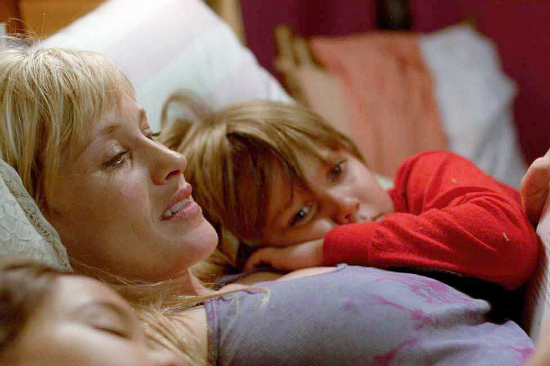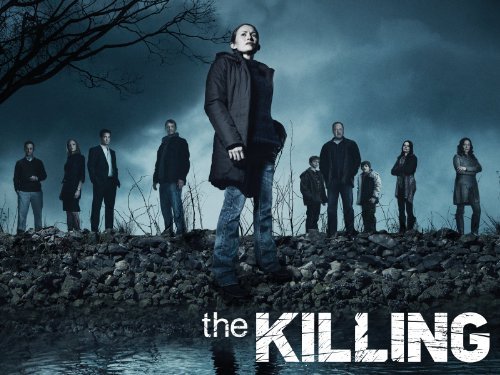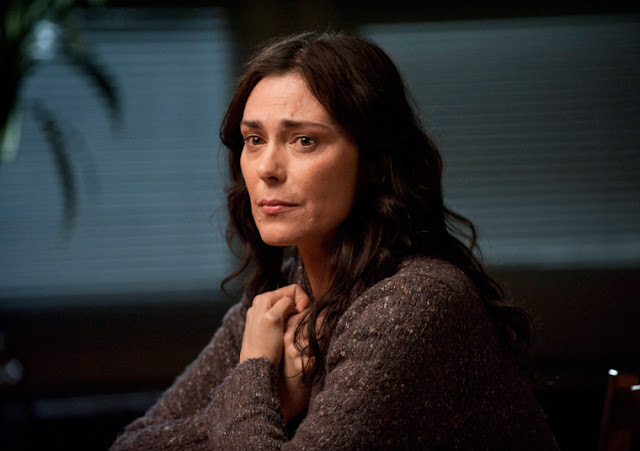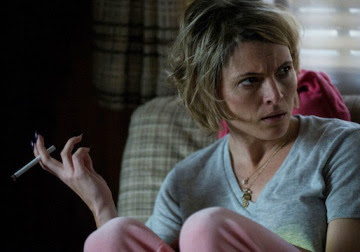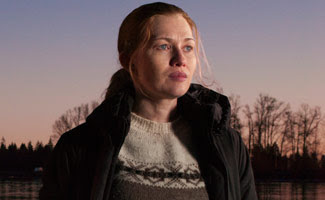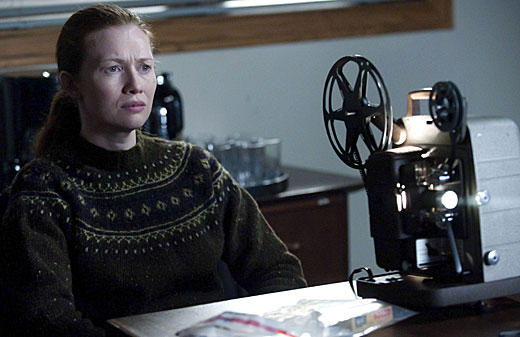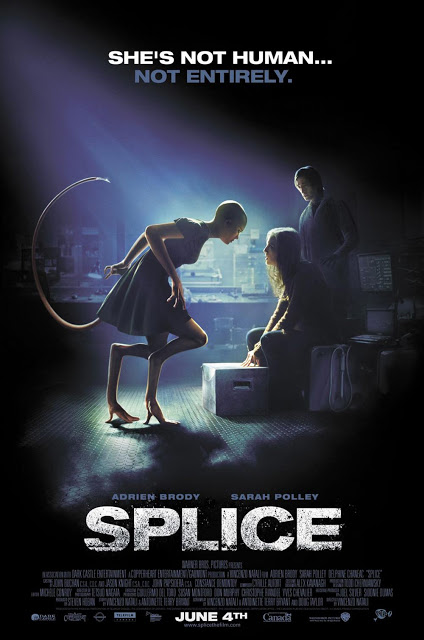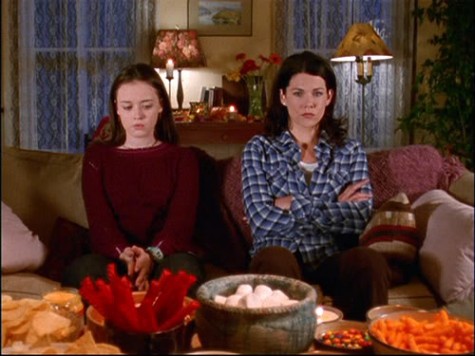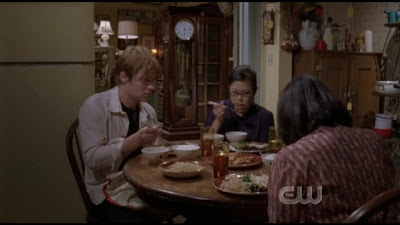This guest post by Deirdre Crimmins appears as part of our theme week on Unlikable Women.
Last year, two completely different films presented two very similar mothers. Though the lead characters from The Babadook and Mommy do not look alike, their parenting styles, and subsequently their sons, are uncanny. This representation of poor parenting by ill-equipped mothers deserves a closer look.
The Babadook is getting showered with praise as one of the best horror films in decades. It is the story of a widow raising an overactive, imaginative son. Samuel is a well-meaning 7-year-old who misbehaves more than not. He throws tantrums. He builds contraptions like backpack-mounted catapults. He has frequent meltdowns. Samuel is not an easy child and mother Amelia is at the end of her rope when a strange book appears on his bookshelf. The story in the book is that of Mr. Babadook, a modern and all too familiar boogeyman. From here the film dives into Amelia’s coping with this monster and her eventual possession by the Babadook.
Mommy is not a horror film at all, though it does have a few moments that are shocking. The film follows Diana, Die, as she tries to deal with her delinquent son, Steve. Fifteen-year-old Steve has just gotten kicked out of the boarding school for problem children and Die must choose between surrendering him to the government or taking him back to her home. She chooses the latter and tries her best to parent Steve as much as he will tolerate. To say that both Steve and Die have unusual boundaries between appropriate and inappropriate is a criminal understatement, as neither of them seems capable of acting like an adult. Even with such rich characters, curiously the most interesting character in the film turns out to be their neighbor, Kyla. For the purposes of this article I won’t have time to explore her further, but it should be mentioned that there is much more subtext in the film that merely the mother-son relationship.
Before diving into the similarities between Die and Amelia, and Mommy and The Babadook, first I will point out one major discrepancy: the two women look completely different. This is not to say that the actresses have different physical attributes, but instead the conscious costuming of each woman is a polar opposite of the other. Die is a flamboyant dresser who styles herself much younger than she is. Everything she wears is tight, embellished, low-cut, and over accessorized. Her hair has chunky highlights that have grown out. Amelia dresses very simply. When she is not in her plain nurse’s uniform she is wearing either a modest sleeping gown (much of the film takes place over night) or an equally unadorned house dress. She wears no real jewelry, and her hair is always pulled back into a bun. Based on costuming alone Die and Amelia would appear to have nothing in common. But as we begin to look at their histories and character flaws, we see that Mommy and The Babadook in fact have a lot in common.

One of the most obvious correlations between the films is that that neither film is American. The Babadook has seen great success in the US, but it is an Australian production. Mommy is Canadian and is in Quebecoise with English subtitles. This is not to say that Hollywood is not capable of portraying poor mothering on screen, but it is interesting that the most striking examples of bad mothers have not come from America. We often see the evil stepmother in fairy tales, but these women are not responsible for raising the children. Also, in fairy tales these children are shown as good children who have overcome their lack of a caring mother. Here we are looking at children that are kind of jerks, perhaps due to the fact that their mothers are not good parents.
The fact that both Amelia and Die are raising sons is also of note. Casually I have heard films about sons and mothers described as horror films and films about mothers and daughters described as melodramas. Psycho and Friday The 13th certainly support the theory; however Carrie and Mommy Dearest swiftly disprove it. Not a solid approach to examining films, but it does bring into question the unique relationship between mothers and sons. Amelia never truly understands Samuel’s obsession with building projectile devices. She supports his creativity as much as she can, but cannot relate to his mechanical talents or even his interest in war and destruction. Die herself has issues relating to Steve. She walks in on him masturbating and brushes it off with a laugh though he is clearly humiliated. Her lack of understanding how valued privacy is, especially for teenagers, is disturbing to the audience and frustrating for Steve.

To further the gender politics of their households and their similarities, both Die and Amelia are widows. Amelia’s husband was killed while she was pregnant with Samuel, a fact that he brings up to complete strangers which makes them quite uncomfortable. Die’s husband died many years earlier, however her predicament is more heartbreaking in that Steve remembers his father. He romanticizes their life together when his father was alive. What is clear about both Die and Amelia is that neither has ever moved on or accepted the deaths. Amelia is still in mourning for her husband and allows her inability to mature to impact her relationship with Samuel and everyone around her. Die is also still in love with her husband and has not moved on romantically, but she has accepted her loss as a part of her life. She is not as paralyzed emotionally as Amelia, but she is still in desperate need of therapy to deal with the loss.
Outside of their family dynamics both mothers rely on caring female neighbors to help them with their problem sons. I briefly mentioned Die’s secretive neighbor Kyla, and symmetrically Amelia also receives help from her neighbor Mrs. Roach. These women are not very good mothers, but they are both good at recognizing that they need help with their sons. Kyla helps Steve pass his exams for his GED, and Mrs. Roach takes Samuel to give Amelia a desperately needed break. These women are not capable of handling their sons on their own.
This is not to say that Amelia and Die are not sympathetic characters. Both want to do the best for their sons, but neither can handle the stress and actual responsibility of disciplining them. I do not mean for this to seem like an attack on Die and Amelia’s parenting skills, but rather a way to look at the sudden appearance of women in film who are not good at parenting. Too often women are shown as having an innate ability to be amazing mothers with little training or support from others. Rather, Mommy and The Babadook show that women are capable of being bad parents. Their maternal instinct is not strong, and their lack of connection to their sons has in turn created sons with disciplinary and behavioral issues. Women on film are frequently shown in terms of extremes: they are either sluts or saints. There is rarely a gray area for representations of women. By showing women who want to do well, but do not have the skills to parent well, it is a step in the right direction for showing women who are imperfect but fully formed characters. Neither Die nor Amelia fit into the mold of the typical mother we see in films, and the developing variety in portrayals of women is quite welcome.
Deirdre Crimmins lives in Boston with her husband and two black cats. She wrote her Master’s thesis on George Romero and is a staff writer for http://www.allthingshorror.com/. You can find her on Twitter at @dedecrim.









